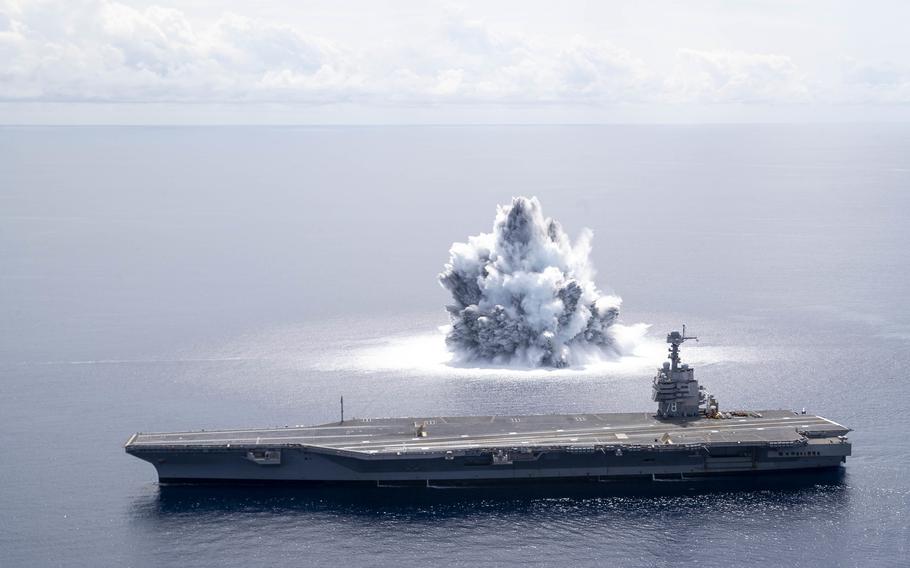
The aircraft carrier USS Gerald R. Ford (CVN 78) completes the first scheduled explosive event of Full Ship Shock Trials while underway in the Atlantic Ocean, June 18, 2021. (Riley McDowell/U.S. Navy)
(Tribune News Service) — Detonating explosives next to the USS Gerald R. Ford during this summer’s shock trials is meant to test the ship — but a team on the carrier makes sure the blasts don’t do the same for marine mammals.
Their watch, in fact, meant the first of three big blasts next to the Ford got off to a late start.
“Once we began our countdown to the explosive event, one of our PSOs (protected species observers) spotted what was suspected to be a marine mammal,” Lt. Cmdr. Desiree Frame said.
“While we can’t control the behavior of marine animals, we were able to change our actions,” she said. “We stopped the countdown for the evolution and held on station until the 3½-nautical mile mitigation zone was clear.”
Rough seas the two previous days had kept the observers from making the kind of careful inspection needed to spot marine life. That, in turn, meant no blast test.
“We’re looking for splashes or any signs of movement,” said Jennifer Klaib, lead PSO on the Ford for the shock trials.
The team of nine observers sent to the Ford for the shock trials use binoculars 25 times as powerful as the standard Navy issue.
Their job is to scan the seas for 3½ miles in every direction from the Ford, beginning hours before the blast.
A spotter plane flies several miles ahead as the Ford moves toward the blast site, and once the carrier is in that area, circles over that 3½-mile exclusion zone.
“The U.S. Navy provides great resources toward environmental protection and doing what’s right out here at sea — it’s where we operate, it’s where we work and we’re passionate about it,” said Capt. Paul Lanzilotta, the Ford’s commanding officer.
The flow chart detailing what to do if a PSO sees a sign of a whale or dolphin was one part of the work of preparing for the shock trials, the first in 35 years to test how well the Navy’s aircraft carriers can weather a close-by explosion.
During the weeks before the shock trial start last month, the Ford’s sailors wired up sensors in every corner of the carrier.
They drilled on scenarios of potential casualties to the crew and damage to the ship.
As the carrier approached last month’s blast site, sailors were on standby at the Ford’s several repair lockers.
“At first, I was on the stretcher bearer team, and then I was moved to the shoring team,” said Seaman Apprentice Britnee McMahon.
“On the shoring team, we would (practice) dealing with any buckled bulkheads or sagging overheads,” she said. “We go in there and place wedges or wood and metal shores to keep the bulkheads and decks from any further damage. I am like anybody else. I do my part.”
©2021 Daily Press.
Visit dailypress.com.
Distributed by Tribune Content Agency, LLC.